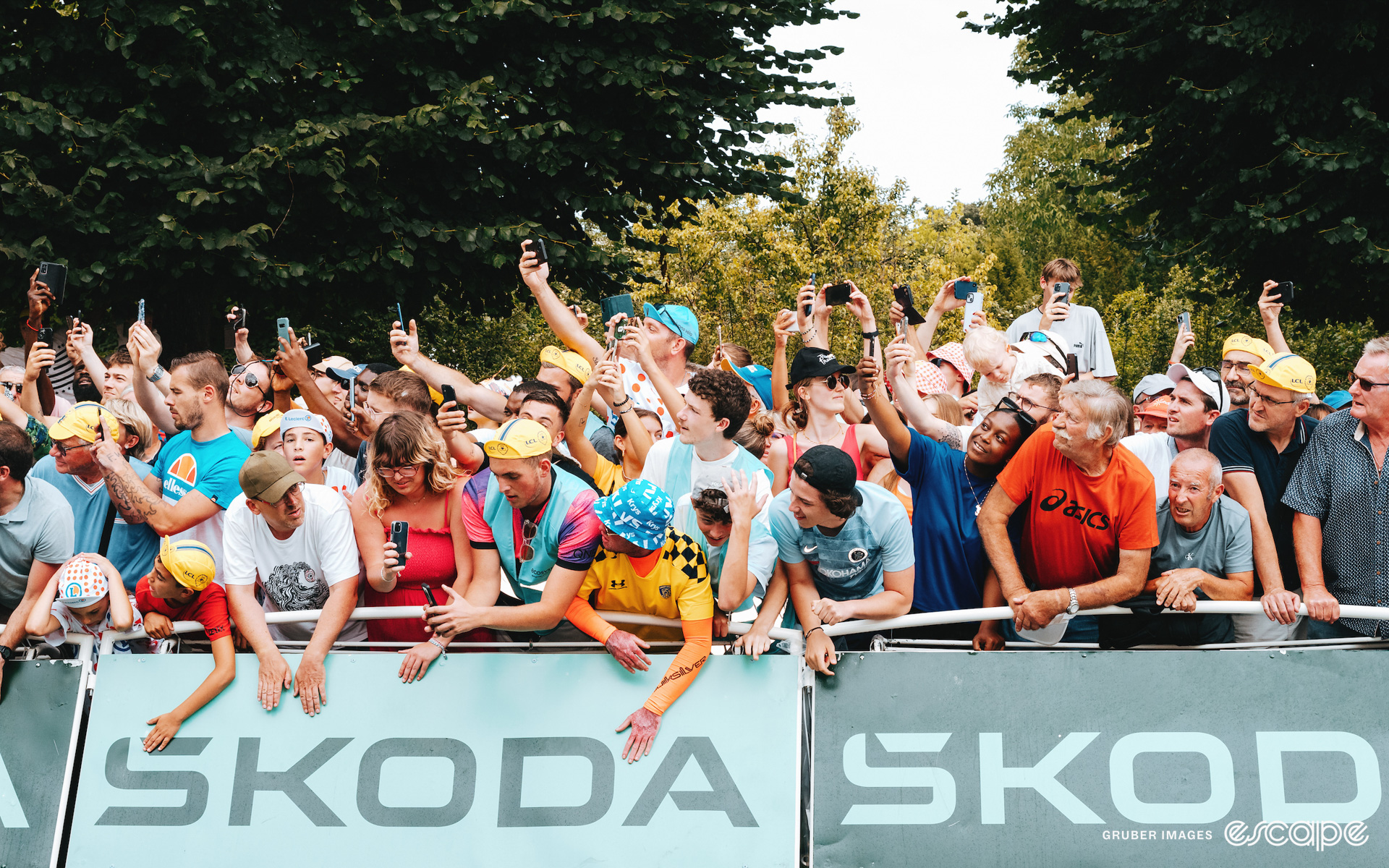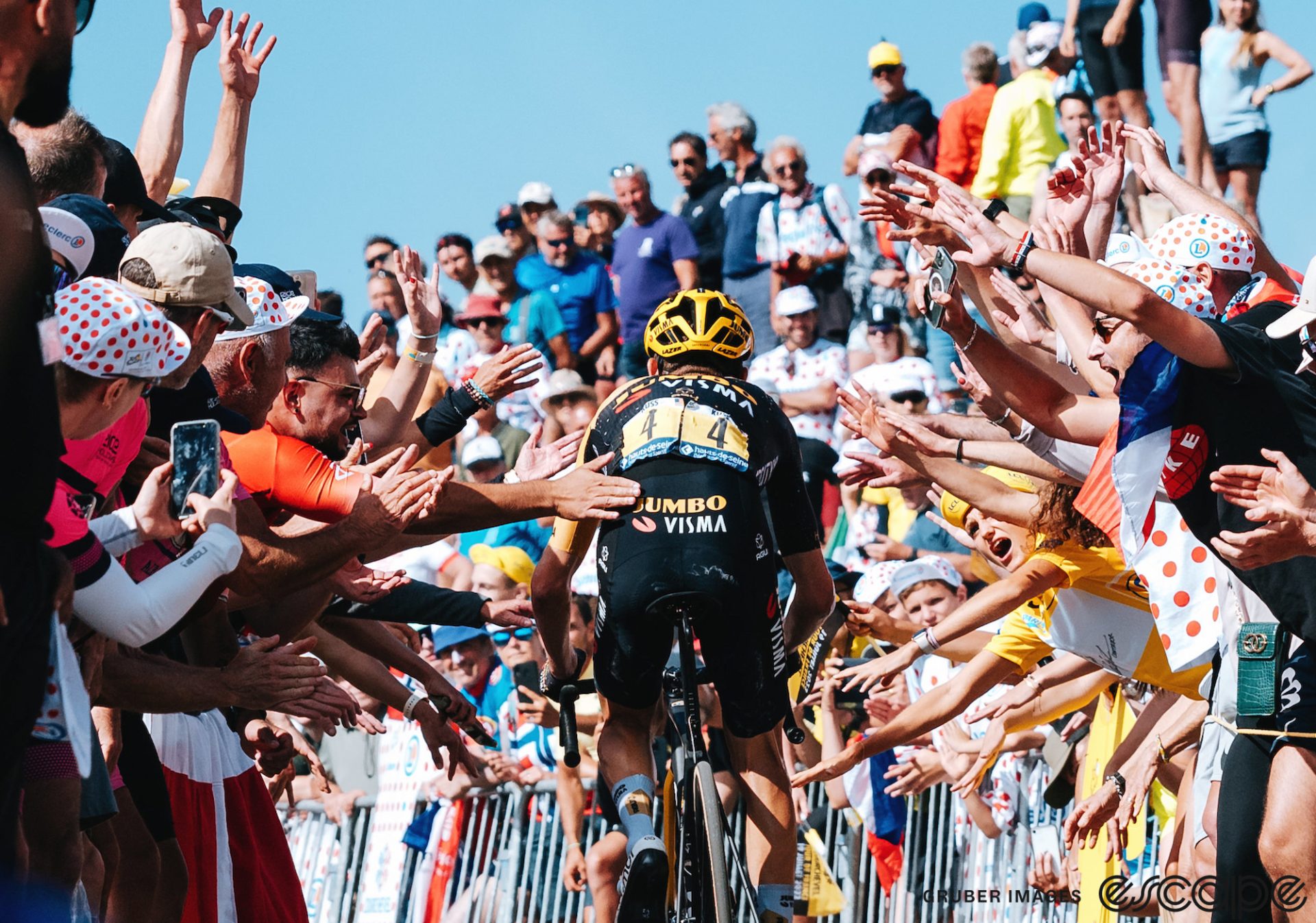Jonas Vingegaard was so far ahead of his competition at the Tour de France that he stopped to take a break with fans. That thought – albeit unlikely – went through my head when the helicopter shot of the yellow jersey on the Col de la Loze showed him momentarily stopped, surrounded by fans.
After all, if Benoit Cosnefroy can do it, why not Vinny-Go?
Alas, no. Amid the chaos, I made out the unmistakable red Skoda of an official Tour director’s car. Then, three motorbikes crowded in an arc next to it, a fourth slightly behind. And in front of the red car in the switchback, a fifth motorbike, this one from France Télévisions, which was surrounded by fans trying to … push it? Keep it from toppling over? It wasn’t clear.
The only thing that was clear was that in the traffic jam, there was nowhere for Vingegaard to go, even with trusted lieutenant Wilco Kelderman to plow a path. For five, seven, 10 long seconds, Vingegaard inched his way through a throng of fans who were delighted to get more than a flashing second or two of time with the race leader.
NBC commentator and ex-pro cyclist Christian Vande Velde was on one of the bikes in question. “It was a comedy of errors,” he told Escape Collective. “The Shimano car, I don’t know if they lost traction or what there, but nonetheless, they stopped. And then Thomas Voeckler was behind him, French television.”
Still, it took race officials to really make things go pear-shaped. According to Vande Velde, “the red car tried to pass us inside. And now everyone’s completely blocked. If he were to just pull behind us, there’s an alleyway for everyone to go up.”
Vingegaard, who Vande Velde said was “pretty chill for the most part,” eventually did get clear of the jam, and was even “helped” by a few enthusiastic fans who miraculously managed to not push him over. In the context – Vingegaard flying up the road to the Loze summit, the Tour’s high point, even as behind, chief rival Tadej Pogačar lost time measured in minutes – it was mostly just a bizarre coda to what was already a surreal day.
This wasn’t nearly a cock-up on the level of Ventoux 2016. Nobody crashed. No yellow jerseys were forced to go for a jog in carbon-fiber shoes. But imagine had things been different. Imagine if Pogačar had not shipped 1:38 in the stage 16 time trial and the race was still close, and was on the attack, or was chasing just behind. Because of the circumstances, this will be the stuff of memes and jokes.
But near-misses are warnings, and we’d best pay attention.
The tip of the iceberg
It’s the second time in four stages that motos and fans have gotten in the way of riders. And if you looked closely today, you could see other near-misses too. Just before Vingegaard got stalled, Pello Bilbao had to fight his way around a clutch of fans to try to keep in contact with Simon Yates. Up ahead, eventual stage winner Felix Gall was nearly swatted by a sign carried by a fez-wearing man who desperately wanted Gall, and TV cameras, to see his message, shittily handwritten in what appeared to be white shoe polish, and illegible even on freeze-frame.
That was just on the Loze, and just the incidents I saw from TV coverage. It’s enough to make you yearn for the Puy de Dôme, where the last 4.5 km were closed to fans. But Matteo Jorgenson, the key animator of that day, didn’t sound like much of a fan of the isolation. Left without a cheering section, he said, he was left only with his own thoughts, and the pain of the effort.
It does seem like this year’s race has been unusually clogged – a little light on fan control; a little heavy on accredited vehicles in the convoy – and it’s easy to advocate for broad, prescriptive fixes. But the details of fixing it are quite a bit harder. How many miles of barriers do we need? Already there is a stratified pecking order to convoy aspects like photo motos that mean some outlets (l’Equipe, owned by the same ASO that runs the Tour) get a prime seat every day while other accredited shooters are shut out entirely.

Bike racing needs fans. It needs the presence of TV commentators like Vande Velde and Voeckler, who can bring us right into the heart of the action. It needs great photos of Pogačar fighting his way up the climb with nothing but a faithful teammate and some grinta to keep the legs going around in circles.
It also needs a little more common sense. As Vande Velde said, “none of us wanted to be in that situation.” But they were. Just as with the stage 15 moto incident, a fine and temporary ban from the race was handed out: Voeckler and his driver are 500 CHF poorer and get a day off tomorrow.
Look, mistakes happen, and they happen fast. There’s a lot of stuff that goes down on Tour that is no one’s fault, exactly, and is more the confluence of a dozen different tiny choices that individually seem innocuous enough before they all collide in one moment to create a crisis. But as the phrase goes, once is an accident, twice a coincidence, and three times a pattern; you can see which direction we’re heading. Whether you’re Voeckler and pilot or the unnamed, unpunished driver of the officials car, a little introspection is in order about how close you came to becoming the day’s Main Character, and perhaps how to avoid that in the future.
And that doesn’t excuse the fans. Already, Steff Cras is out of the race thanks to an inattentive fan, so long ago now that most have forgotten. Sepp Kuss and Nathan van Hooydonck got Opi-Omi’d, thankfully without the same severity of consequences. I’m missing dozens of other events, most of them near-misses thanks to luck and the skill and attention of the racers.
A sign of the times?
Was it always this way? After all, you can go back and name any number of incidents from recent or more distant pasts: Vincenzo Nibali crashed by overexuberant (and perhaps over-served) fans on Alpe d’Huez in 2018; Lance Armstrong taken down by an errant musette strap waved by a fan in 2003; Giuseppe Guerini unintentionally body-slammed by a photo-taking fan – again, on Alpe d’Huez, the perennial Souvenir Henri Desgrange of loutish behavior – en route to the stage win in 1999.

But something certainly feels different now. Maybe it’s how in some of the roadside randoms Ashley and Jered Gruber shoot, a disconcerting number of fans are holding up their phones – looking at riders on screens even as the race passes right in front of them – as if it’s more important to document you were there than to enjoy the experience at all.
Or how there’s a certain self-consciousness to many of the fans who run alongside the riders; how it seems like they’re not running so much because the emotional moment has overcome them, but because they’re keenly aware that the cinematic moment, and the cameras that document it, has finally come to them and so this has now become their moment, which they are determined to seize.
Here’s where I might attempt to veer into an examination of self-image, fraying social connection, and the digital panopticon we have voluntarily opted into constructing, but I’m not a smart enough nor incisive enough a commentator to make that work. I only know that however much of this we have artificially made for ourselves, its attraction is built on deeply natural psychology; I feel the phantom tug of my smartphone and that tiny validation of a new notification as much as anyone.
Now, make that your literal job; you’re Vande Velde or Voeckler and your task is to bring fans into the sui generis heart of the action. Your producer wants the home viewer to feel the hot press of the crowd in perfect 4K while the roar rumbles through the subwoofer. The Loze traffic jam is later promoted on NBC’s social channels as “insane scenes” and has 169,000 views and rising. Is it any wonder we all press in closer, closer, until – only too late – we discover we’re too close?

All manner of technical fixes will be suggested: fewer motos and other vehicles in the convoy; better fencing and crowd barriers; more gendarmes; charges for fans who interfere with the sport. All perfectly well-intentioned and yet, likely, unsatisfyingly ineffective because what we are dealing with is nothing less than human nature.
Fans make the Tour. The literal arms-length distance to the action is what gives the race its magical connection with us. We should hold that sacred, never want it to change. But could we perhaps preserve it by being a little more self-aware? Can we learn again to appreciate the act of roadside spectating as something to be experienced rather than recorded? Can we grasp the difference between shoving a sign in one GC rider and stage hunter’s face as he tries to stay with a rival and joyously, raucously dancing around another, in 107th overall, who’s YOLO’ing his way through the Tour?
Can we, literally and figuratively, take just one step back?
Did we do a good job with this story?

